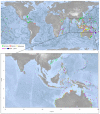Biomedical Potential of the Neglected Molluscivorous and Vermivorous Conus Species
- PMID: 35200635
- PMCID: PMC8878422
- DOI: 10.3390/md20020105
Biomedical Potential of the Neglected Molluscivorous and Vermivorous Conus Species
Abstract
Within the Conidae family, the piscivorous Conus species have been a hotspot target for drug discovery. Here, we assess the relevance of Conus and their other feeding habits, and thus under distinctive evolutionary constraints, to highlight the potential of neglected molluscivorous and vermivorous species in biomedical research and pharmaceutical industry. By singling out the areas with inadequate Conus disquisition, such as the Tamil Nadu Coast and the Andaman Islands, research resources can be expanded and better protected through awareness. In this study, 728 Conus species and 190 species from three other genera (1 from Californiconus, 159 from Conasprella and 30 from Profundiconus) in the Conidae family are assessed. The phylogenetic relationships of the Conidae species are determined and their known feeding habits superimposed. The worm-hunting species appeared first, and later the mollusc- and fish-hunting species were derived independently in the Neogene period (around 23 million years ago). Interestingly, many Conus species in the warm and shallow waters become polyphagous, allowing them to hunt both fish and worms, given the opportunities. Such newly gained trait is multi originated. This is controversial, given the traditional idea that most Conus species are specialized to hunt certain prey categories. However, it shows the functional complexity and great potential of conopeptides from some worm-eating species. Pharmaceutical attempts and relevant omics data have been differentially obtained. Indeed, data from the fish-hunting species receive strong preference over the worm-hunting ones. Expectedly, conopeptides from the fish-hunting species are believed to include the most potential candidates for biomedical research. Our work revisits major findings throughout the Conus evolution and emphasizes the importance of increasing omics surveys complemented with further behavior observation studies. Hence, we claim that Conus species and their feeding habits are equally important, highlighting many places left for Conus exploration worldwide. We also discuss the Conotoxin drug discovery potentials and the urgency of protecting the bioresources of Conus species. In particular, some vermivorous species have demonstrated great potential in malaria therapy, while other conotoxins from several worm- and mollusc-eating species exhibited explicit correlation with SARS-CoV-2. Reclaiming idle data with new perspectives could also promote interdisciplinary studies in both virological and toxicological fields.
Keywords: Conus; biomedical compounds; distribution map; feeding habit; phylogenetic tree.
Conflict of interest statement
The authors declare no conflict of interest.
Figures



Similar articles
-
Beyond Conus: Phylogenetic relationships of Conidae based on complete mitochondrial genomes.Mol Phylogenet Evol. 2017 Feb;107:142-151. doi: 10.1016/j.ympev.2016.10.008. Epub 2016 Oct 27. Mol Phylogenet Evol. 2017. PMID: 27794464
-
χ-Conotoxins are an Evolutionary Innovation of Mollusk-Hunting Cone Snails as a Counter-Adaptation to Prey Defense.Mol Biol Evol. 2024 Nov 1;41(11):msae226. doi: 10.1093/molbev/msae226. Mol Biol Evol. 2024. PMID: 39470581 Free PMC article.
-
High accuracy mass spectrometry comparison of Conus bandanus and Conus marmoreus venoms from the South Central Coast of Vietnam.Toxicon. 2013 Dec 1;75:148-59. doi: 10.1016/j.toxicon.2013.06.005. Epub 2013 Jun 21. Toxicon. 2013. PMID: 23792454
-
Human injuries and fatalities due to venomous marine snails of the family Conidae.Int J Clin Pharmacol Ther. 2016 Jul;54(7):524-38. doi: 10.5414/CP202630. Int J Clin Pharmacol Ther. 2016. PMID: 27285461 Review.
-
Insulin as a weapon.Toxicon. 2016 Dec 1;123:56-61. doi: 10.1016/j.toxicon.2016.10.010. Epub 2016 Oct 21. Toxicon. 2016. PMID: 27777069 Review.
Cited by
-
Peptide Toxins from Marine Conus Snails with Activity on Potassium Channels and/or Currents.Toxins (Basel). 2024 Nov 22;16(12):504. doi: 10.3390/toxins16120504. Toxins (Basel). 2024. PMID: 39728762 Free PMC article. Review.
-
Using Constellation Pharmacology to Characterize a Novel α-Conotoxin from Conus ateralbus.Mar Drugs. 2024 Feb 29;22(3):118. doi: 10.3390/md22030118. Mar Drugs. 2024. PMID: 38535458 Free PMC article.
-
Chemical Synthesis and Insecticidal Activity Research Based on α-Conotoxins.Molecules. 2024 Jun 14;29(12):2846. doi: 10.3390/molecules29122846. Molecules. 2024. PMID: 38930912 Free PMC article.
-
Predatory and Defensive Strategies in Cone Snails.Toxins (Basel). 2024 Feb 7;16(2):94. doi: 10.3390/toxins16020094. Toxins (Basel). 2024. PMID: 38393171 Free PMC article. Review.
-
Diversity and Novelty of Venom Peptides in Vermivorous Cone Snails, Subgenus Rhizoconus (Gastropoda: Mollusca).Mar Drugs. 2025 Jun 26;23(7):266. doi: 10.3390/md23070266. Mar Drugs. 2025. PMID: 40710491 Free PMC article.
References
-
- Duda T.F., Kohn A.J., Palumbi S.R. Origins of diverse feeding ecologies within Conus, a genus of venomous marine gastropods. Biol. J. Linn. Soc. 2001;73:391–409. doi: 10.1111/j.1095-8312.2001.tb01369.x. - DOI
-
- Richard G., Rochelle L. Panorama sur La Diversite des Conidae 110 Espèces Prédatrices des Plus Efficaces. 2021. [(accessed on 7 January 2022)]. Available online: https://www.researchgate.net/publication/353337774_PANORAMA_SUR_LA_DIVER....
-
- Franklin J.B., Apte D.A. Two New Records of Conidae (Mollusca: Caenogastropoda) from the Andaman Islands, India. J. Bombay Nat. Hist. Soc. 2020;117:152546.
Publication types
MeSH terms
Substances
LinkOut - more resources
Full Text Sources
Miscellaneous

